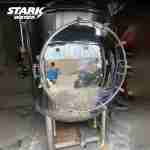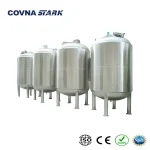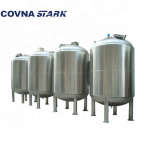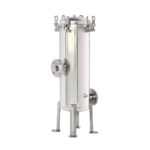Stainless steel water tanks are a reliable solution for safe, long-lasting water storage across homes, businesses, and industries. However, like any storage system, they require regular maintenance to ensure hygiene and water quality. Over time, sediment, biofilm, and microbial growth can accumulate, affecting both safety and performance.
In this guide, we’ll walk you through the complete process of how to clean a stainless steel water tank efficiently and safely. Whether you're maintaining a rooftop tank at home or a large commercial water system, these best practices apply to all tank sizes and configurations.
Why Regular Cleaning Is Important
Many users choose stainless steel water tanks because of their durability, corrosion resistance, and hygiene advantages. However, “low maintenance” does not mean “no maintenance.” Over time, even stainless steel tanks can accumulate sediments, bacterial film, and chemical residues—especially if the source water contains minerals, organic matter, or comes from rainwater harvesting systems.
From a customer perspective, here’s why regular tank cleaning is essential:
-
1. Protect Your Health:
Contaminated water can cause gastrointestinal illness, skin irritation, or infections. Even microscopic biofilms can harbor harmful bacteria like E. coli, especially in warm, stagnant tanks. Cleaning ensures safe water for your family or customers. -
2. Ensure Clean Drinking Water:
If your tank is used for potable water—especially in residential, hospitality, or hospital settings—periodic disinfection prevents unpleasant tastes, odors, or chlorine demand issues downstream. -
3. Extend the Lifespan of Your Tank:
Residues such as iron deposits, sand, or algae can corrode the inner seams and welds over time. Routine cleaning removes these threats before they compromise your tank’s integrity. -
4. Optimize System Efficiency:
In commercial and industrial setups, clogged pipelines, pump damage, or membrane fouling often begin with unclean tanks. A clean tank keeps the entire system running efficiently. -
5. Comply with Regulations:
For food-grade, pharmaceutical, and public water supply systems, sanitation records and tank cleaning logs are mandatory. Cleaning regularly ensures you meet ISO, GMP, or local health codes. -
6. Avoid Expensive Repairs:
Ignoring periodic cleaning can lead to tank leaks, microbial blooms, or clogged filters—all of which cost far more to fix than a routine maintenance visit.
We recommend cleaning residential tanks every 6–12 months, and commercial tanks every 3–6 months depending on water quality and usage volume. For sensitive industries like healthcare or food & beverage, follow a documented cleaning SOP and disinfection schedule.
Tools and Materials Needed
Before starting the cleaning process, it's essential to gather the right tools and cleaning agents. Using improper equipment—like metal brushes or acidic cleaners—can scratch or damage the stainless steel surface, compromising both hygiene and durability.
Here is a checklist of tools and materials we recommend:
-
Protective Gear:
Rubber gloves, goggles, and optionally a mask to protect yourself from splashes and cleaning fumes. -
Mild Detergent or Baking Soda:
Safe, non-abrasive cleaners to remove organic residue, light staining, and odor without corroding stainless steel. -
Chlorine Bleach (5% Sodium Hypochlorite):
For thorough disinfection. Ensure it's food-grade and properly diluted. -
Soft-Bristle Brush or Sponge:
Helps remove debris without scratching the inner tank surface. Avoid steel wool or metal pads. -
Wet/Dry Vacuum or Manual Pump:
Useful for removing residual water or sludge after draining. -
Clean Water Supply:
For rinsing the tank thoroughly after cleaning and disinfection. Use potable water for tanks storing drinking water. -
Flashlight or Headlamp:
Provides visibility inside large or enclosed tanks during inspection and cleaning.
Make sure all materials are clean, food-safe, and compatible with stainless steel. For large industrial tanks or rooftop installations, consider safety harnesses and proper ventilation during cleaning.
Step-by-Step Cleaning Process
Cleaning a stainless steel water tank is a simple yet critical maintenance task. Whether your tank is 500 liters or 50,000 liters, following a structured process ensures both efficiency and safety. Here is a recommended cleaning protocol:
-
1. Drain the Tank:
Shut off the water supply. Open the outlet valve to drain as much water as possible. Use a wet/dry vacuum or pump to remove residual water from the base. Be cautious of slippery surfaces during this step. -
2. Rinse the Interior:
Use a hose or clean bucket to rinse down all internal surfaces with potable water. This helps dislodge sediment and organic debris before scrubbing. -
3. Scrub the Inner Walls:
Apply a mild detergent or baking soda solution to the tank’s surfaces. Use a soft-bristle brush or sponge to scrub gently—starting from the top and working downward. Pay special attention to corners, seams, and outlets. -
4. Rinse Thoroughly:
Remove all detergent residues by rinsing 2–3 times with clean water. Never leave soap residue inside tanks meant for potable or food-grade applications. -
5. Disinfect the Tank:
Mix 1 liter of chlorine bleach (5% sodium hypochlorite) with 100 liters of water to prepare a safe disinfecting solution. Fill the tank partially and use a brush or sponge to coat all internal surfaces. Let it sit for 2–4 hours, keeping the tank closed during disinfection. -
6. Final Flush:
Drain the disinfectant solution completely. Rinse the tank thoroughly until there is no smell of bleach remaining. Use drinking-quality water for final rinses if the tank is used for potable purposes. -
7. Reconnect and Refill:
After confirming the tank is dry and clean, reconnect the inlets and outlets. Restore the water supply and refill as normal.
For industrial tanks, add an inspection step post-cleaning—checking for weld integrity, vent filters, and overflow functionality. For rooftop or high-elevation tanks, ensure safety measures are followed during access and cleaning.
Maintenance Tips for Stainless Steel Water Tanks
Cleaning your stainless steel water tank is only part of the equation. Long-term performance and hygiene depend on regular maintenance. By adopting a simple preventive care routine, you can extend the tank’s life and ensure clean water at all times.
-
1. Inspect Every 6 Months:
Schedule a visual inspection of your tank interior and exterior twice a year. Look for signs of corrosion, loose fittings, biofilm buildup, or water discoloration. -
2. Clean at Recommended Intervals:
Residential tanks should be cleaned every 6–12 months depending on water source (rainwater requires more frequent cleaning). Commercial and industrial systems should be cleaned every 3–6 months. -
3. Check Inlet Filters and Screens:
Install mesh screens or pre-filtration systems at the inlet to block debris, dust, and insects. Clean these filters regularly to reduce tank contamination. -
4. Use a First-Flush Diverter:
For rainwater harvesting tanks, install a first-flush system to redirect dirty initial rainwater away from the tank. -
5. Prevent Algae Growth:
Keep your tank covered and sealed. Stainless steel reflects light well, but algae can still form if direct sunlight enters through vents or gaps. -
6. Avoid Harsh Chemicals:
Do not use acidic or abrasive cleaners (e.g., hydrochloric acid or steel wool) as they can damage the passivation layer of the stainless steel. -
7. Maintain Records:
Keep a simple cleaning log or maintenance checklist, especially for tanks used in regulated environments (e.g., hospitals, hotels, manufacturing plants).
Proactive tank care reduces emergency repairs, preserves water quality, and keeps your system operating efficiently. At STARK, we not only supply high-grade stainless steel tanks—we also support your long-term water storage strategy.
Why Choose STARK Stainless Steel Water Tanks?
At STARK, we specialize in the design and manufacture of premium stainless steel water tanks that are engineered for durability, hygiene, and long-term performance. Our tanks are built to international quality standards, making cleaning and maintenance simple for every user—from private homeowners to commercial facility managers.
- Quality Materials: We use only certified SUS304 and SUS316L stainless steel, ensuring corrosion resistance and food-grade water safety.
- Custom Solutions: Whether you need a compact rooftop tank or an industrial-scale reservoir, we offer a wide range of sizes and configurations to suit every application.
- Easy Cleaning & Maintenance: Our tanks are designed for easy access, effective drainage, and rapid inspection—helping you maintain perfect water quality with less effort.
- Global Support: STARK serves customers worldwide with technical advice, installation guidance, and after-sales service.
Ready to upgrade your water storage solution? Contact STARK today to learn more about our stainless steel water tanks, get expert cleaning advice, or request a free consultation. Protect your health, your property, and your investment with a brand you can trust.









